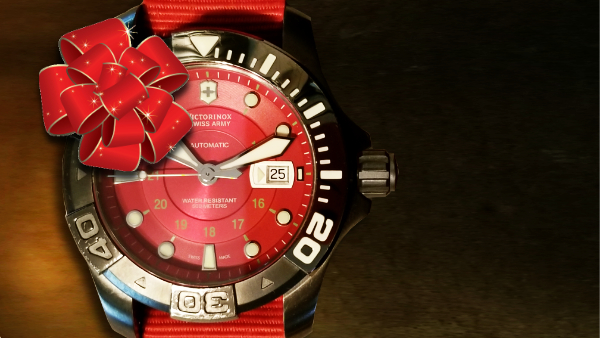Choosing a watch is tough enough, but buying a watch as a gift can be tougher. Read on to learn how to choose which watch to give as a gift.
I recently received a comment from a reader about purchasing a high-end watch for her fiancee. Her name was Brittany and she was open to let me help her point her in the right direction to finding something special for her future husband on their special day. The whole process of picking something as personal as a watch for someone else really got me thinking.
So, I thought I would put up a post to help people learn about watches and how to choose one for someone else. Hopefully my experience with buying watches can help guide others to finding the perfect gift for the one/s they love. Thanks Brittany for the comment and good luck with the search!
As with any search it starts with getting the right information. I first asked Brittany some basic questions. I’m going to outline my questions below along with what each question means to me from a watch buying perspective.
Contents
Things to Consider When Buying a Watch as a Gift
- Is it for a man or a woman?
This makes a huge difference. Men’s watches are often their only jewelry as well as a tool in man’s tool box. Where with women, they are often much more jewelry-oriented and will have to complete or compliment other pieces of jewelry. (Check out our list of women’s watches under $150.) - Is it the only watch he or she will wear, is one of several, or does it need to fulfill a specific need?
This is often the determining question. For example, if the gift-tee is looking for a dive watch for actual diving it is much easier to focus on that category than a watch that will have to work under all circumstances if it’s the only watch they will wear. - What is your budget?
This is pretty obvious…The higher the amount to work, the harder it gets and the more choices you have. As the price increases, I start to expect more and more from a watch. At $1,000, I expect a quality timepiece that will last a lifetime. At $10,000, I expect a limited-edition watch that comes with a pedigree and a piece of history. At $20,000, I expect a pedigree and a high precious metal content. - What’s the purpose of the watch beyond telling time?
This is a hard one. If the watch is meant to impress, you must ask who it is that your impressing. A watch connoisseur is harder to impress than your average Joe. Something I always find interesting is that my big, gaudy, showy watches get more comments and attention than my pricier, quality, classic watches. Of course I don’t tend to hang out with watch aficionados, so go figure. - How does your gift-tee dress?
Fairly straight forward. If the gift-tee wears a suit and tie every day, you probably don’t want to get them a big honking tool diver watch. Unless of course their other outfits include wetsuits and scuba tanks on a regular basis. As rule; suits = dress watches; casual attire = everyday watches; sweat pants = big bling or G-Shocks; Carhart’s = tough work watches…You get the idea. - Do they have any hobbies that need to be addressed?
Again, its straight forward. If they are into boating, go for a yachting watch. If they are into planes, go for an aeronautical-inspired watch. If they are into cars, go for something car-related. If you look around there is a watch for almost any occasion and hobby.
Next, Iron Out the Details for the Watch
The next step after answering some basic questions is to figure out the details: Type of movement, case material, legibility, durability etc.
Watch Movements
I always like to start with the movement. There are three basic types of watch movements, with a few variations that are worth noting. The different type of watch movements include; Quartz (battery powered), Automatic (powered by the movement of your wrist) and Manual (you must physically wind them.)
They each have their strengths and weakness. In terms of accuracy, Quartz is first with automatic watches second and then manual. (These are general rules, and there are many exceptions.)
There are few others that are unique. One of my favorites is the Seiko Kinetic movement. It’s like an automatic movement, but instead of winding the main spring of a watch, it charges a capacitor that acts like a battery and then powers a quartz movement.
I have several of these watches, and I like them very much. My big problem with them is that when I don’t wear them, they die, and it’s a pain to get them going again.
The other big one is solar powered watches. These are again quartz watches with a little solar panel built into the dial that provides power to the movement. Citizen has an extensive line called Eco-Drive, which keep great time as long as they get some sunlight on a regular basis.
When you get into the higher end brands, they are almost all automatic or manual movements, and many have developed their own in-house movements (part of the reason they cost so much). This does not necessarily make them better than the mass market movement, just more exclusive.
Also, when you get into the higher end brands, they tend to make their cases out of precious metals rather than steel, bronze, or titanium. The case material will mostly affect the wear of the watch. For example, gold watch cases are heavy and may show more wear, while titanium is light, strong, and wears well.
Obviously, the more precious the material, the higher the price. Solid gold and platinum watches often start in the tens of thousand of dollars and go up from there.
This covers the basics, but check out my page on watch movements for more information.
Size of the Watch
Next up on my list of decisions would be the size of the case. Most watches are listed in millimeters, with typical case sizes ranging from around 28mm up to more than 50mm in width.
Length is also important as it determines how the band wraps around the wrist. If the lug-to-lug (the little arms that stick out where the band attaches) distance is to short, you see a lot of band on the top of the wrist with the watch. If the lug-to-lug distance is too long, the watch risks sticking out of the edge, leaving a gap where the band starts.
The other dimension to consider is the height of the watch, super thin watches start at around 3-4mm, with super thick ones running 20mm plus. I find the 9-15mm heights the most comfortable, with 10-11mm being perfect for me.
Dial Color, Legibility, and Complications
Next up on the shopping list would be dial color, legibility and complications. A watches complication includes all the extra features that a watch can have, aside from telling time. I have watches that have alarms, chronographs (stopwatches), second time zones, depth gauge, thermometer, compass, altitude measurement, barometer and more.
Typically, the more complicated a dial, the less legible it is. I’ve noticed that the older I get, the more important legibility is for me.
Watch Color
Color plays a big role in my watch choices. You can only have so many black and white dials before things get boring. But, I also don’t want to be rocking a bright orange watch dial with all my outfits.
Another thing to consider is if the gift-tee will change bands. A great watch can be worn on multiple bands, letting it match whatever occasion is at hand. Changing my watch bands is one of the things I love most about watch collecting. Each watch I own has multiple looks and personalities simply by changing the band. (Learn more in my post about watch straps.)
Which Watch Should You Choose as a Gift?
Below are a few links to some of the brands that I own and can whole heartily recommend. I’ve listed them by general price range, so you can start your search based on price.
Best Watch Brands by Price
$250 – $750 Watches: Maranez; Seiko Prospex; Zelos; Steinhart
$750 – $1,500 Watches: Hamilton; Zodiac; Archimede; Stowa; Halios; Magrette
$1,500 – $5,000 Watches: Bell & Ross; Sinn; Christopher Ward; Nomos Glashutte
$5,000+ Watches: Omega; Panerai; IWC
This is by no means a complete list, there are hundreds of interesting watches and watch brands out there. Have fun and good luck hunting! Also check out my watch brands by country section for more ideas.



